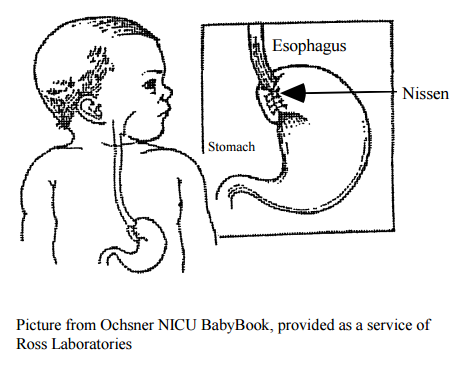Nissen fundoplication
What is a Nissen fundoplication?
A Nissen fundoplication is one of the most common surgical procedures used to treat severe gastroesophageal reflux (GER).
GER is the backup of stomach contents into the esophagus (the tube between the mouth and the stomach).
A Nissen procedure is performed by wrapping part of the upper stomach around the lower part of the esophagus to create a nipple valve that stops the reflux.

What can I expect after surgery?
While asleep under anesthesia, your child may have had a nasogastric (NG) tube placed through the nose into the stomach. The tube is connected to gentle suction to keep the stomach empty. An empty stomach promotes healing.
Your doctor will decide when the tube can be removed, usually when your child is passing gas or has bowel movements.
Instead of the NG tube, some children may have a gastrostomy tube, a tube through the skin of the abdomen (belly) directly into the stomach.
After the NG tube is removed, your child can begin to drink clear liquids, progressing to eating regular foods as tolerated.
The incision will be covered by Tegaderm®, a bandage that looks like clear plastic, and/or Steristrips® (little pieces of tape) or Dermabond (skin super-glue). The stitches will dissolve on their own.
Your child will also have an IV, a plastic tube that goes into the vein, to give fluids and medicines. An IV is needed until your child is drinking well.
In addition, your child:
- will need to eat more slowly.
- may feel full earlier (may eat smaller amounts at one time).
- may not be able to burp.
- may gag but not be able to vomit.
- may become bloated (stomach fills with gas and swells).
What will be done for pain?
Every effort will be made to keep your child as comfortable as possible. Your doctor will prescribe medicine to relieve pain.
How should I care for my child at home?
Your child may have a tub bath. Do not soak the incision. The plastic dressing should be removed in a week. Steristrips or Dermabond will fall off on their own.
Encourage quiet play. No active play or swimming until seen by the doctor.
When should I call the surgeon?
- increased swelling, redness, or pain at the incision or the area around it
- drainage from the incision
- signs of reflux return
- temperature higher than 100.5° F by mouth or 101.5° F rectally
Questions?
This sheet is not specific to your child but provides general information. If you have any questions, please call the clinic.
Children's Hospitals and Clinics of Minnesota
Patient/Family Education
2525 Chicago Avenue South
Minneapolis, MN 55404
Last reviewed 8/2015 ©Copyright
This page is not specific to your child, but provides general information on the topic above. If you have any questions, please call your clinic. For more reading material about this and other health topics, please call or visit Children's Minnesota Family Resource Center library, or visit www.childrensmn.org/educationmaterials.
© 2024 Children's Minnesota
